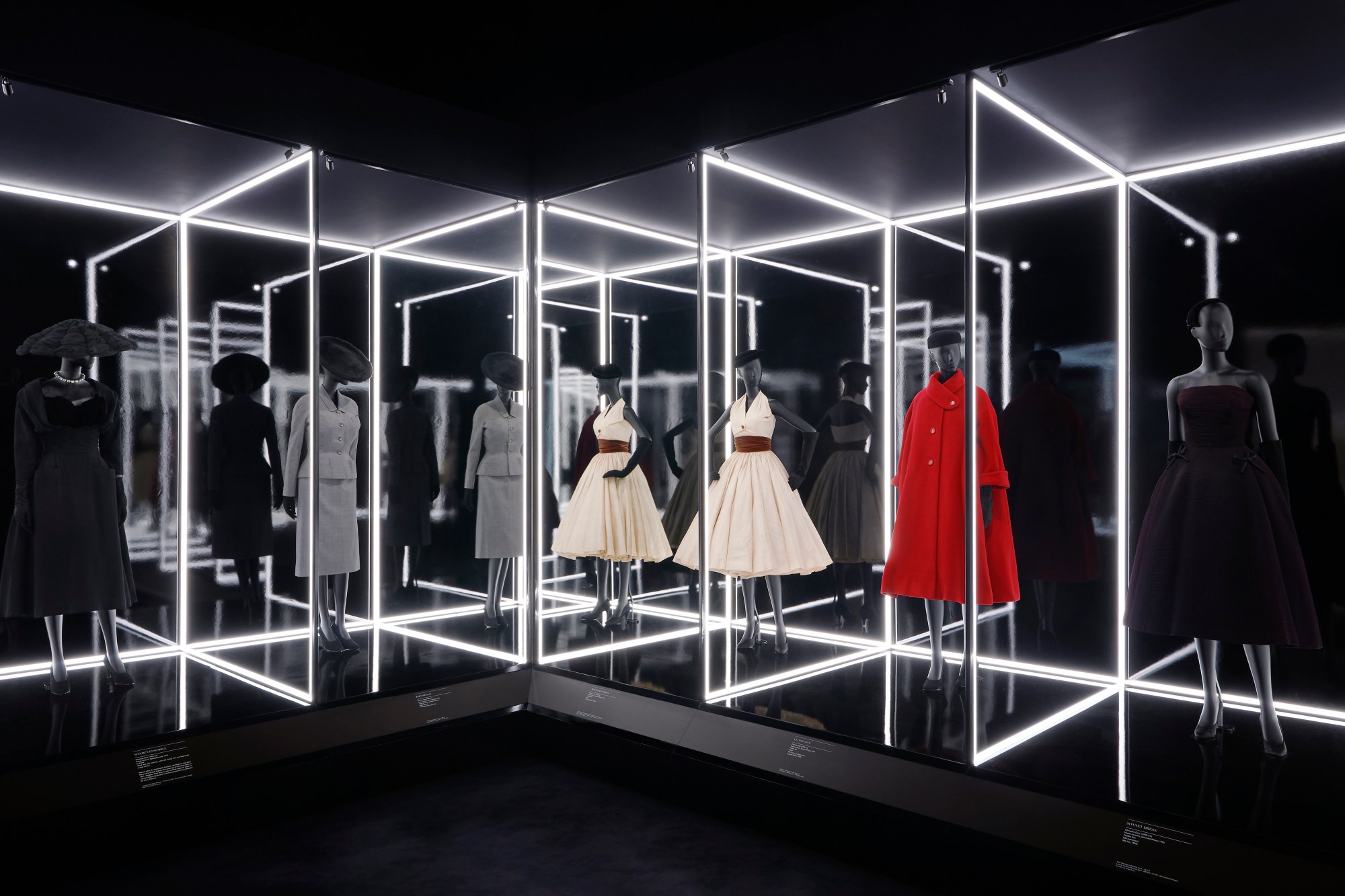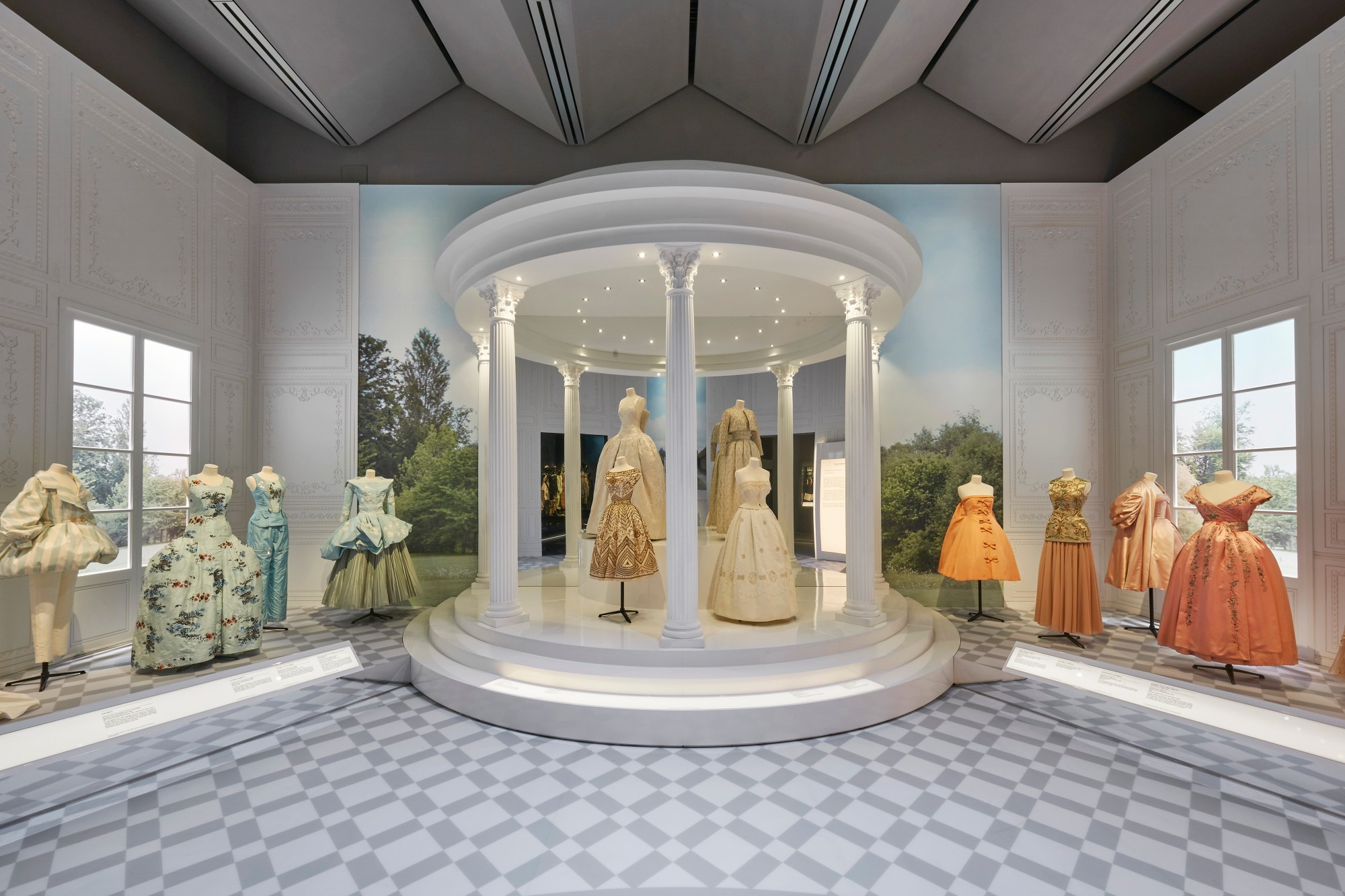As the V&A opens its biggest fashion exhibition since the record-breaking Alexander McQueen: Savage Beauty, prepare to lose yourself in the beauty of Dior and the craftsmanship of couture. Across 11 spaces, 500 objects including 200 rare dresses are being exhibited alongside accessories, fashion photography, film, perfume, make-up, illustrations, magazines, and Christian Dior’s personal possessions – Christian Dior: Designer of Dreams traces the history and impact of one of the 20th century’s most influential couturiers, and the six artistic directors who succeeded him. Beyond getting to know Monsieur Dior better, visitors are able to explore the house’s thematic changes right through to the first woman to take creative control, Maria Grazia Chiuri.
How much do you know about the 72-year-old luxury house that Christian Dior built? Do you know how Dior launched the label in post-WWII Paris and became one of the 20th century’s most influential couturiers? Do you know what New Look is beyond the high street chain? What do you know about the designers who carried on Dior’s legacy after his death? Have you seen the dress that Princess Margaret wore for her 21st birthday celebrations? Designer of Dreams teaches you all this and so much more.

The exhibition is a romantic reimagination of the Dior Disneyland that was last year’s Musée des Arts Décoratifs exhibition in Paris. “The curator makes the difference,” Maria Grazia Chiuri explains as we sit in the English Garden room, surrounded by dresses made by Monsieur Dior himself, Yves Saint Laurent, Marc Bohan, Gianfranco Ferré, John Galliano, Raf Simons and her own. “You see similar things through different eyes. The curator sees Dior with a different point of view. In Paris, you saw a more French vision, this one is very British. I reflect on cultural differences because this is the first time that I’ve worked at a house that wasn’t Italian, working with people from all over the world, but the DNA is French,” Maria explains.
Chiuri compares her role to that of a curator and believes it is her duty to connect with people and have a voice. “I strive to be attentive and open to the world, to create fashion that resembles the world of today,” she says. As the first female Design Director in Dior’s 71-year-history, Maria Grazia Chiuri has, since her appointment in 2016, carefully crafted a new chapter for the French luxury house and brought the debate around female empowerment to Paris Fashion Week. Chiuri’s collections have often looked back to move forward, and have continually connected fashion to feminism. The use of Linda Nochlin’s battle-cry essay Why Have There Been No Great Women Artists? in her spring/summer 18 collection and Chimamanda Ngozi Adichie’s We Should All Be Feminists in her powerful debut have reverberated around the world, and placed fashion directly within the wider discussions around women’s equality, inspiring many other designers to follow her lead.

Immersed in a history that has been largely shaped by men, the significance of Maria Grazia Chiuri being the first female to helm Dior is obvious. “Of course, as a woman, I have another point of view,” Chiuri adds succinctly. “For me, I don’t want to impose on other women, I want to start a conversation and I want the house to be a place that takes care of women. Fashion can impose certain rules but when I was young and interested in fashion, it was about being free, expressing our own identity.”
As we admire the dramatic silhouettes of Gianfranco Ferré and reminisce about John Galliano’s fantastical story-telling, I ask if she has a particular favourite moment of Dior history? “Everytime I spend time in the archive, I discover something different that sparks inspiration but it’s always reliant on my own moment,” she notes. “I personally love Marc Bohan because he was working in the 60s and 70s, a time that reflects my own coming-of-age moment, a time of huge sociopolitical revolution, of gender… of sex.” Although often overlooked today, Bohan is the house of Dior’s longest-serving creative director and steered it through the cultural shifts of the 60s, 70s and 80s. “His pieces are the ones I want to wear now. There’s something so timeless about them. When he became creative director he said, ‘N’oubliez pas la femme’, we must not forget the women, and that’s my own point of view too.”

“Ultimately, people see Dior, not all the designers that made up Dior,” Chiuri explains modestly as we explore the Designers room. “All of the designers, from Yves to Raf, have in their own way used the reference of the founder and the codes of the house, in their own personal style and reflected their own moment but if you aren’t a fashion historian or a fashion obsessive, it is difficult to see.” The exhibition itself makes these links most obvious in a number of its rooms, the Ballroom, Travels, Historicism and Garden. As we sit back down in the latter, we can see just how successive designers have celebrated the green fingered Monsieur Dior. Yves Saint Laurent frequently inserted the rose motif into his designs, while Marc Bohan, Gianfranco Ferré and John Galliano, were all keen gardeners and often adorned their collections with floral embroideries. Then of course, we should all recall how Raf Simons’s debut Dior collection was presented against a backdrop of a million fresh flowers, while for her first couture collection for Dior, Maria Grazia Chiuri created dresses with hand-dyed silk petals which resembled delicately pressed flowers trapped between layers of silk tulle. Dreamy. But despite this, we see her point. If you don’t look at the plaques, it’s all Dior and that’s the power of this great house. “I want them to see that Dior is a house that has been able to maintain its values over a long time, while being a model of the time,” Maria says.
Also, as someone who remembers how she felt when she visited the McQueen, Bowie and Frida Kahlo exhibitions at the V&A, she longs to stir emotions, create memories and educate. “Today, when everything moves so fast, it’s so important to promote this type of exhibition where you can talk about fashion in a different way,” she explains. “A picture seen through a small window on a screen, you can only see so much. We have a responsibility to show more and to educate. Beyond image, it has to be about experience.”

Now, this desire to create experiences has been reflected in Chiuri’s recent Dior shows. From the the resort 2019 show, in which she brought Mexican ‘Escaramuza’ equestriennes to Chantilly, to the spring/summer 19 ready-to-wear show set against a backdrop of the Tel Aviv–based choreographer Sharon Eyal’s dance troupe and the showcase of female strength by the London-based acrobatic troupe for her latest couture show, Chiuri isn’t interested in blink-and-you’ll-miss-it catwalk shows.
With Designer of Dreams, Dior are able to create a different experience. “For me, this exhibition is even more important than a show because you can share this experience with far more people,” she explains excitedly. “For a show, you can only invite one thousand guests, it’s exclusive but here, everyone can come. It’s a way to communicate the value of couture to a new generation. We have to educate. It’s more important to promote the beauty behind the fashion, the craftsmanship, the brand. Here, more people can see so much more.” We have no doubt that Designer of Dreams will surpass the record-breaking Savage Beauty exhibition, so book your tickets now.
Christian Dior: Designer of Dreams runs from 2 February – 14 July 2019 at the V&A
